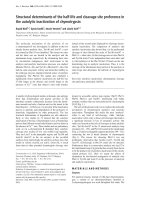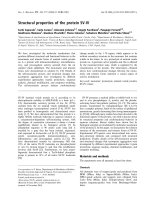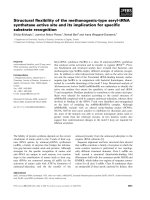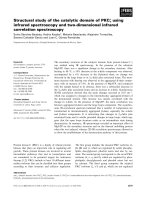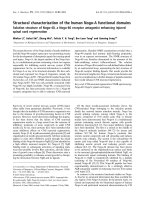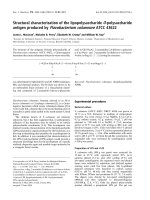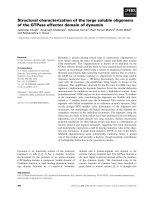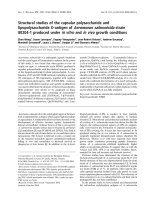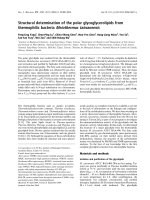Báo cáo sinh học: " Structural comparisons of the nucleoprotein from three negative strand RNA virus families" pdf
Bạn đang xem bản rút gọn của tài liệu. Xem và tải ngay bản đầy đủ của tài liệu tại đây (509.43 KB, 7 trang )
BioMed Central
Page 1 of 7
(page number not for citation purposes)
Virology Journal
Open Access
Hypothesis
Structural comparisons of the nucleoprotein from three negative
strand RNA virus families
Ming Luo*, Todd J Green, Xin Zhang, Jun Tsao and Shihong Qiu
Address: Department of Microbiology, University of Alabama at Birmingham, Birmingham, AL, 35294, USA
Email: Ming Luo* - ; Todd J Green - ; Xin Zhang - ; Jun Tsao - ;
Shihong Qiu -
* Corresponding author
Abstract
Structures of the nucleoprotein of three negative strand RNA virus families, borna disease virus,
rhabdovirus and influenza A virus, are now available. Structural comparisons showed that the
topology of the RNA binding region from the three proteins is very similar. The RNA was shown
to fit into a cavity formed by the two distinct domains of the RNA binding region in the rhabdovirus
nucleoprotein. Two helices connecting the two domains characterize the center of the cavity. The
nucleoproteins contain at least 5 conserved helices in the N-terminal domain and 3 conserved
helices in the C-terminal domain. Since all negative strand RNA viruses are required to have the
ribonucleoprotein complex as their active genomic templates, it is perceivable that the (5H+3H)
structure is a common motif in the nucleoprotein of negative strand RNA viruses.
Background
Negative strand RNA viruses are different from all other
viruses because their RNA genomes are always enwrapped
by a virally coded nucleoprotein (N) to form a ribonucle-
oprotein (RNP) complex. This complex serves as the tem-
plate for viral RNA synthesis (the plus strand cRNA, the
negative strand vRNA or mRNA) and form the structural
core when packaged into virions. The RNP is formed con-
comitant with replication of viral genomic RNAs by the
viral RNA-dependent RNA polymerase. The RNP structure
is a unique feature of negative strand RNA viruses such
that the polymerase complex can only copy the RNA
sequence in the RNP, not naked RNA. In addition, virion
assembly also requires the RNP structure to be packaged
in the virion. These unique functions that are common
among negative strand RNA viruses may require con-
served structural motifs in the N protein. Such conserva-
tion has been observed in capsid proteins of spherical
viruses which share a β-barrel motif [1]. The eight strand
β-barrel has the general property of encapsidating nucle-
otides and self-assembly into an icosahedral shell. Struc-
tural similarities have also been noticed in the coat
proteins of three other icosahedral virus groups that sug-
gested evolutionary lineages in the virus group. dsDNA
virus (e.g. adenovirus), tailed dsDNA viruses (e.g. bacteri-
ophages), and dsRNA viruses (e.g. reovirus) share com-
mon protein folds in their coat proteins and common
architectures in virion assembly [2].
Crystal structures of the N protein from borna disease
virus (BDV) [3], two rhabdoviruses, vesicular stomatitis
virus (VSV) [4] and rabies virus (RABV) [5], and influenza
A virus (FLUAV) [6], have been reported. The structures of
the rhabdovirus N proteins were determined with RNA
bound in a cavity. The cavity is located between two sepa-
rated domains that accommodate the RNA with both
hydrophobic and charged/polar interactions. Extended N-
termini and a loop in the C-terminal domain reach over
Published: 10 July 2007
Virology Journal 2007, 4:72 doi:10.1186/1743-422X-4-72
Received: 18 May 2007
Accepted: 10 July 2007
This article is available from: />© 2007 Luo et al; licensee BioMed Central Ltd.
This is an Open Access article distributed under the terms of the Creative Commons Attribution License ( />),
which permits unrestricted use, distribution, and reproduction in any medium, provided the original work is properly cited.
Virology Journal 2007, 4:72 />Page 2 of 7
(page number not for citation purposes)
neighboring molecules to form an extended protein net-
work along the RNA. The BDV and FLUAV N proteins
were determined as a tetramer and a trimer, respectively,
in the absence of RNA. The collection of N protein struc-
tures from three negative strand RNA viruses makes it pos-
sible to identify conserved structural motifs in the
nucleoprotein from different virus families. We found
that the RNA binding region of the N protein contains an
N-terminal domain and a C-terminal domain with a sim-
ilar topology in the N protein structures of all three virus
families. In the RNA binding cavity, a central α-helix sur-
rounded by four α-helices in the N-terminal domain con-
tinues to a central α-helix surrounded by two α-helices in
the C-terminal domain. By superimposing the rhabdovi-
rus N protein structure with that of BDV and FLUAV, this
structural motif was also present in the other two struc-
tures. This suggests that the (5H+3H) structure may be a
common motif in the nucleoprotein of negative strand
RNA viruses.
Hypothesis
Superposition of
β
-barrels in the viral capsid proteins
The β-barrel structural motif of spherical viruses can serve
as benchmarks for recognizing conserved structural folds
in other viral proteins. Four spherical viruses were
selected, including human rhinovirus serotype 16
(HRV16, PDB accession code 1AYM
) viral protein 1 (VP1)
and viral protein 2 (VP2) [7], a single stranded RNA virus,
the C-subunit of the southern bean mosaic virus (SBMV,
coordinates retrieved from the Protein Data Bank (PDB)
with accession code 4SBV
([8], a plant RNA virus, capsid
protein of satellite tobacco mosaic virus (STMV, PDB
accession code 1A34
) [9], a small plant RNA virus, and the
L1 protein of human papillomavirus (HPV, PDB acces-
sion code 1DZL
) type 16 [10], a double stranded DNA
virus. The coordinates of HRV16-VP2 and the last three
viral capsid proteins were aligned with that of HRV16-VP1
using FATCAT (Figure 1) and the results are tabulated in
Table 1. The structural alignment of the coordinates in
each comparison was carried out by the method of Flexi-
ble structure AlignmenT by Chaining AFPs (Aligned Frag-
ment Pairs) with Twists (FATCAT) [11,12].
Superposition of individual domains
The BDV N protein consists of 370 amino acids, the N
protein from VSV and RABV consists of 422 and 450
amino acids, respectively, and the FLUAV N (commonly
known as NP) protein consists of 489 amino acids. There
is no detectable homology at the amino acid sequence
level among these N proteins. The structures of the VSV
(PDB access code 2GIC
) and the RABV (PDB accession
code 2GTT
) N proteins were superimposed with that of
the BDV N protein (PDB accession code 1N93
), respec-
tively, by use of the FATCAT program with either rigid or
flexible alignments [11]. Since the two N structures from
the two rhabdoviruses are nearly identical, only the VSV N
protein was used as the representative rhabdovirus N pro-
tein for subsequent analyses. The results of superposition
of VSV N with that of BDV N are summarized in Table 2
and 3.
The topology of the protein fold is essentially the same
between the VSV and BDV N structures each of which is
composed of two domains (Figure 2). The central core of
the N protein structure contains 7 aligned helices in the N-
terminal domain and 5 aligned helices in the C-terminal
domain. The N-terminal domain is directly linked by
helix α8 to helix α9 in the C-terminal domain. The struc-
ture of the C-terminal domain is more conserved than
that of the N-terminal domain (Figure 3, Table 2 and 3).
The two domains may change their relative orientations
in the RNA binding region if the N protein needs to encap-
sidate the RNA in a slightly different mode, such as bind-
ing a more or less number of nucleotides per N protein
Table 2: Structural alignment of the C-terminal domains
RMSD (Å) ‡ P-value Aligned residues BDV N C-domain: (residues 230–346,
109 amino acids)
FLUAV N C-domain: (residues 213–271, 59
amino acids)
VSV N C-domain: (residues 224–341, 118 amino
acids)
3.44
3.17e-5
97
3.60
2.49e-2
46
BDV N C-domain: (residues 230–346, 109 amino
acids)
4.23
5.19e-3
53
‡ For each paired comparison, three values were provided as listed in this box.
Table 1: Structural alignment of the β-barrel fold
RMSD (Å) P-value
Aligned residues
HRV16-
VP2 (252
residues)
SBMV C-
sub (222
residues)
STMV
(147
residues)
HPV (233
residues
≠
)
HRV16-VP1 (285
residues)
3.06
1.57e-3
145
3.02
1.63e-3
149
3.50
1.63e-1
108
3.56
1.16e-1
111
≠In the L1 capsid protein of HPV, three large loops and the C-
terminal extension were removed to isolate the β-barrel fold for
the alignment.
Virology Journal 2007, 4:72 />Page 3 of 7
(page number not for citation purposes)
molecule. Nevertheless, in addition to the apparent topo-
logical similarity, the overall structure of the two N pro-
teins has a very similar shape despite the difference in the
orientation of the individual domains (Figure 4).
A negatively charged surface groove was identified in the
FLUAV N structure, but the RNA binding region was not
clearly mapped in the previous report [6]. We found that
the region comprised of residues 21–271 of the FLUAV N
protein (PDB accession code 2IQH) is structurally similar
to the RNA binding region of the VSV N protein, but the
two domains within this region are positioned differently
in the FLUAV N structure (see below). This shows that the
two domains in the FLUAV N structure have a large
change in their relative orientations compared to those in
the VSV N structure. As a result, each domain in the two
proteins could only be superimposed separately (Figure
5). The C-terminal domain again is structurally more con-
served between VSV and FLUAV N proteins with second-
ary structure elements arranged by a similar topology
(Figure 2, Table 2 and 3). The N-terminal domain of the
FLUAV N structure could only be superimposed with that
of the VSV or BDV N structure when the core residues 56–
147 from the N-terminal domain were included.
Each N protein has other secondary structural elements
that are not aligned (Figure 2). For instance, there is a long
loop between the second and the third conserved α-heli-
ces (α3 and α4 in the VSV N protein) in the N-terminal
domain, with a β-hairpin at the tip of the loop. This loop
is also present in the N-terminal domain of the BDV N
protein as shown by the flexible superposition of the two
structures [11], but it is pointing to the opposite direction
as a result of the insertion of an α-helix (α4 in the BDV N
protein). The C-terminal end of the VSV N protein beyond
the C-terminal domain includes three consecutive α-heli-
ces whereas that of the BDV N protein contains only one.
There are 3
10
helices between the third and fourth α-heli-
ces (α11 and α12 in the VSV N protein) in the C-terminal
domain (three 3
10
helices in the BDV N protein and one
Table 3: Structural alignment of the N-terminal domains
RMSD (Å) ‡ P-value Aligned residues BDV N N-domain: (residues 50–229, 180
amino acids)
FLUAV N N-domain: (residues 21–202 [56–
147]*, 73 amino acids)
VSV N N-domain: (residues 46–223, 178 amino
acids)
4.03
3.90e-3
133
3.61
8.16e-2
55
BDV N N-domain: (residues 50–229, 180
amino acids)
3.09
1.33e-2
45
‡ For each paired comparison, three values were provided as listed in this box.
*Note: When the N-terminal domain of the FLUAV N protein was superimposed with other N-terminal domains, only the core region (residues
56–147) was used in the superposition.
β-barrel comparisonsFigure 1
β-barrel comparisons. (a) Stereo Cα drawings for the superposition of the β-barrel fold in HRV16-VP2 (cyan) with that in
HRV16-VP1 (red). (b) SBMV (blue) with HRV16-VP1 (red). (c) STMV (green) with HRV16-VP1 (red). (d) HPV (yellow) with
HRV16-VP1 (red). In this and the following figures, the Cα tracing was prepared with RIBBONS [14] and protein structural
cartoons were prepared with PyMol [15].
Virology Journal 2007, 4:72 />Page 4 of 7
(page number not for citation purposes)
in the VSV N protein). Additional α-helices can be found
in the BDV N protein (Figure 2). In the case of the FLUAV
N protein, the region that is superimposable with the RNA
binding region of the VSV N protein contains essentially
the same number of secondary structural elements except
for helix α13 of the VSV N protein. The rest of the FLUAV
N protein (residues 272–489) has no homologous coun-
terpart in either VSV or BDV N proteins. These residues
constitute an additional domain near the C-terminal end
of the FLUAV N protein.
RNA binding cavity
Since structures of both BDV and FLUAV N proteins were
determined in the absence of RNA, comparisons to the
structure of the N-RNA complex of VSV could help in
identifying the residues that interact with RNA. When the
crystal structure of the BDV N protein was first published,
the authors observed highly positively charged areas in
the interior surface of the tetrametic BDV N protein. How-
ever, it appears that it is difficult to thread an RNA strand
through the center of the tetramer. In fact, all the crystal
structures of the N proteins reported so far were oligomers
that are much smaller than the RNP, with or without RNA.
The RNP has an extended structure with a large number of
N protein molecules lining side-by-side on the genomic
RNA, including the BDV RNP [13]. The interior of the
RNA binding cavity in the rhabdovirus N protein is mostly
hydrophobic, which accommodates the bases that point
toward the N protein [4,5]. This hydrophobic region is
also found in that of the BDV N protein, but comprising
of nonhomologous residues. Six positively charged resi-
dues in the VSV N protein were identified to interact with
the phosphate groups in the bound RNA, three in the N-
terminal domain (Arg143, Arg146 and Lys155), and three
in the C-terminal domain (Lys286, Arg317 and Arg408)
(Figure 6). In the BDV N protein, four positively charged
residues are located near those residues in the VSV N pro-
tein, one in the N-terminal domain (Lys154) and three in
the C-terminal domain (Arg287, Arg297 and Lys311)
(Figure 6B). If the C-terminal domains in the VSV and
BDV N proteins are aligned as the anchor, the BDV N pro-
Comparisons of the VSV and BDV N structuresFigure 3
Comparisons of the VSV and BDV N structures. Stereo Cα
drawings for the superposition of the C-terminal domain in
the VSV N protein (blue) with that of the BDV N protein
(yellow) (upper panel), and the N-terminal domain of the
VSV N protein (blue) with that of the BDV N protein (green)
(lower panel). Residue positions of the aligned structures are
shown in the box below each structural comparison. '1'
marks the aligned residues between the two structures. Car-
toon drawings are also presented on the right with α-helices
in VSV N labeled.
Topology drawings for the C-terminal domain (top panel) and the N-terminal domain of the N proteinsFigure 2
Topology drawings for the C-terminal domain (top panel)
and the N-terminal domain of the N proteins. Large circles
represent α-helices and triangles represent β-strands. Small
circles represent 3
10
helices. Color codes are from blue to
red orange, corresponding to the sequence distance to the
N-terminus similar as in Figure 4. Lines above the circles rep-
resent connections on top of the helices, whereas lines
below the circles represent the connections at bottom of the
helices. The secondary structure elements are labeled the
same as in the reported crystal structures. The dotted gray
colored circle in the FLUAN C-terminal domain implies a
possible disordered α-helix and the gray circle implies a mis-
match of a loop with an α-helix.
Virology Journal 2007, 4:72 />Page 5 of 7
(page number not for citation purposes)
tein seems to have a cavity composed of 5 helices from the
N-terminal domain and 3 helices from the C-terminal
domain, with a similar size as that in the VSV N protein
(Figure 5).
The two domains of the FLUAV N structure corresponding
to the RNA binding region of the VSV N protein have very
different positions compared to the other structures (Fig-
ure 7A). For this reason, residues that may be similar to
the RNA binding residues in the VSV N cavity could not be
definitely identified. If the C-terminal domain of the
FLUAV N protein is aligned with that of the VSV N pro-
tein, the N-terminal domain and the additional domain at
the C-terminal end of the FLUAV N protein would close
the cavity that is present in the rhabdovirus N protein
(Figure 7A). The structural comparisons discussed above
have shown that the two domains are separately con-
served structural domains and may assume various orien-
tations relative to each other. It is not unacceptable that
the orientations of the two domains in the FLUAV N pro-
tein in an RNA-free conformation may be changed in an
RNA-bound conformation. To explore that possibility, an
open conformation was simulated by aligning each
domain individually, i.e. the N-terminal domain and the
C-terminal domain of the FLUAV N protein were aligned
with those of the VSV N protein as in Figure 5. Next, the
additional domain at the C-terminal end is manually
positioned to match the extreme C-terminal end of the
VSV N protein. This maneuver requires only rotations
(twists) of two clearly defined structural domains in the
FLUAV N protein. The final simulated open conformation
of the FLUAV N protein (Figure 7B) is essentially derived
from the N conformation that is observed in the VSV N-
RNA complex.
Oligomerization
The N protein polymerizes on the genomic RNA during
replication. Neighboring N molecules form an extended
network of interactions along the entire length of the RNA
genome. In the VSV N protein, there is a 1954 A
2
buried
area side-by-side between two monomers while the bur-
ied area is 2680 A
2
in the BDV N protein. The larger buried
area in the BDV N proteins could be the result of the tetra-
meric oligomerization, which has a 90° angle between
Comparisons of the VSV and FLUAV N structuresFigure 5
Comparisons of the VSV and FLUAV N structures. Stereo
cartoon drawings for the superposition of the C-terminal
domain of the FLUAV N protein (yellow) with that of the
VSV N protein (blue), and the superposition of the N-termi-
nal domain of the FLUAV N protein (dark green) with that of
the VSV N protein (blue). The two domains in the FLUAV N
protein were aligned with their counterparts in the VSV N
proteins as separate domains. In the case of the N-terminal
domain, only the core residues 56–147 were included in the
calculation for structural alignment by FATCAT. Residue
positions of the aligned structures are shown in the box
below each structural comparison. '1' marks the aligned resi-
dues between the two structures. Cartoon drawings are also
presented on the right with α-helices in VSV N labeled. Sta-
tistics for the domain alignments could be found in Table 1B
and 1C.
The structures of the VSV and the BDV N proteins com-pared to the (5H+3H) motifFigure 4
The structures of the VSV and the BDV N proteins com-
pared to the (5H+3H) motif. The aligned helices are labeled
by black lettering in each structure.
Virology Journal 2007, 4:72 />Page 6 of 7
(page number not for citation purposes)
two neighboring molecules compared to an angle of 144°
or 147° for the rhabdovirus N proteins that were crystal-
lized as a 10 mer and 11 mer, respectively, with RNA
bound. The BDV N protein molecules would have to asso-
ciate through more extended side-by-side interactions in
the RNP, which should have similar contact areas between
the neighboring
N molecules as observed in the rhabdovirus N-RNA com-
plexes. The extended C-terminal and N-terminal arms in
both structures reach over the neighboring molecules to
add further intermolecular interactions. The oligomeriza-
tion arrangement of the reported FLUAV N structure [6] is
so different that it is impossible to make a meaningful
comparison of the reported FLUAV N oligomer with that
of the rhabdovirus or BDV N proteins. Comparisons of
how the interactions between the FLUAV N proteins con-
tribute to encapsidation of the RNA genome would
become more apparent if a structure of the FLUAV N-RNA
complex becomes available.
Testing the hypothesis
Comparisons of the N protein structures from three virus
families showed that the RNA binding region in each N
protein has a similar structure containing two domains.
The overall structure of the rhabdovirus N protein can be
superimposed with that of the BDV N protein, whereas
the FLUAV N protein could only be superimposed with
the other N proteins as separate N-terminal and C-termi-
nal domains. However, it appears that the fold of the indi-
vidual domains are conserved in the N proteins to a
degree similar to that of the β-barrel fold in the capsid pro-
teins of spherical viruses. There are five helices in the N-
terminal domain and three helices in the C-terminal
domain that are common among the N structures of the
three virus families. This motif, which we have named the
(5H+3H) motif, may be a common motif responsible for
encapsidating RNA by the N protein of negative strand
RNA viruses (Figure 2). The helices α8 and α9 named as
in the VSV N protein are at the center of the motif and con-
nect the two domains in the motif. However, the spatial
geometry of the helices in the (5H+3H) motif is variable
when the structures were compared. One possible expla-
nation for this observation is that the structures of the
BDV and FLUAV N proteins were determined without
RNA bound [3,6] whereas those of the VSV and RABV N
proteins were determined with a random RNA molecule
bound in the RNA binding cavity [4,5]. The orientation of
the helices in the BDV or FLUAV N protein might change
when the N protein binds RNA. This question could be
answered when the structure of the BDV or FLUAV N pro-
tein is determined in the presence of bound RNA. An
alternative explanation could be that there are intrinsic
differences in the three dimensional structure of the N
Cartoon drawings for the superposition of the FLUAV N protein with that of the VSV N protein (gray)Figure 7
Cartoon drawings for the superposition of the FLUAV N
protein with that of the VSV N protein (gray). (a) Superposi-
tion of the FLUAV N protein as in the reported crystal struc-
ture. Only the C-terminal domain of the putative RNA
binding region of the FLUAV N protein was included in the
calculation for the structural alignment by FATCAT [11]. The
N-terminal domain of the putative RNA binding region in the
FLUAV N protein was colored green, the C-terminal
domain, yellow, and the addition domain at the C-terminal
end of the FLUAV N protein, blue. (b) Superposition of a
hypothetical structure of the FLUAV N protein with the
structure of the VSV N protein. The orientation of the C-
terminal domain is the same in (a) and (b). The N-terminal
domain (green) was aligned with the N-terminal domain of
the VSV N protein as in Figure 5. The additional domain at
the C-terminal end (blue) was positioned by twisting the tor-
sion angles of the peptide chain including residues 295–297
(indicated by the red arrow) to match the loop at the end of
the VSV C-terminal domain.
The RNA binding cavity of the VSV N protein (red) with highlighting the positively charged residues that interact with the RNAFigure 6
The RNA binding cavity of the VSV N protein (red) with
highlighting the positively charged residues that interact with
the RNA. For comparison, the similar region in the BDV N
protein (cyan) was presented. Positively charged residues
that could potentially interact with the RNA are also high-
lighted in the BDV N structure. The sidechain of Arg297 in
the BDV N structure was disordered in the crystal structure
(not shown in this figure).
Publish with BioMed Central and every
scientist can read your work free of charge
"BioMed Central will be the most significant development for
disseminating the results of biomedical research in our lifetime."
Sir Paul Nurse, Cancer Research UK
Your research papers will be:
available free of charge to the entire biomedical community
peer reviewed and published immediately upon acceptance
cited in PubMed and archived on PubMed Central
yours — you keep the copyright
Submit your manuscript here:
/>BioMedcentral
Virology Journal 2007, 4:72 />Page 7 of 7
(page number not for citation purposes)
proteins, a likely result of evolution despite commonality
of the structure and function of the N proteins among
negative strand RNA viruses.
Implication of the hypothesis
The structural alignments of the N proteins from three
negative strand RNA virus families have significant predic-
tive values in recognizing the RNA binding site and the
side-by-side interactions of the BDV N protein, which was
not revealed when the BDV N structure was determined
alone in the absence of bound RNA. The chemical proper-
ties of the homologous cavity in the BDV N protein and
the pattern of intermolecular interactions are consistent
with its functions to assemble the viral RNP. It also sug-
gested a possible conformation of the FLUAV N protein
which may be more suitable for RNA binding than the
conformation observed in the recent crystal structure.
Competing interests
The author(s) declare that they have no competing inter-
ests.
Authors' contributions
ML, TJG, XZ, JT, SQ generated data used in the analysis,
proposed and discussed the hypothesis. ML and TJG wrote
the manuscript. All authors read and approved the final
manuscript.
Acknowledgements
This work is supported in part by NIH grants AI050066 and AI057157.
References
1. Rossmann MG, Johnson JE: Icosahedral RNA virus structur. Annu
Rev Biochem 1989, 58:533-573.
2. Bamford DH, Grimes JM, Stuart DI: What does structure tell us
about virus evolution? Curr Opin Struct Biol 2005, 15:655-663.
3. Rudolph MG, Kraus I, Dickmanns A, Eickmann M, Garten W, Ficner
R: Crystal structure of the borna disease virus nucleoprotein.
Structure 2003, 11:1219-1226.
4. Green TJ, Zhang X, Wertz GW, Luo M: Structure of the vesicular
stomatitis virus nucleoprotein-RNA complex. Science 2006,
313:357-360.
5. Albertini AA, Wernimont AK, Muziol T, Ravelli RB, Clapier CR, Sch-
oehn G, Weissenhorn W, Ruigrok RW: Crystal structure of the
rabies virus nucleoprotein-RNA complex. Science 2006,
313:360-363.
6. Ye Q, Krug RM, Tao YJ: The mechanism by which influenza A
virus nucleoprotein forms oligomers and binds RNA. Nature
2006, 444:1078-1082.
7. Hadfield AT, Lee W, Zhao R, Oliveira MA, Minor I, Rueckert RR,
Rossmann MG: The refined structure of human rhinovirus 16
at 2.15 Å resolution: implications for the viral life cycle. Struc-
ture 1997, 5:427-441.
8. Silva AM, Rossmann MG: Refined structure of southern bean
mosaic virus at 2.9 A resolution. J Mol Biol 1987, 197:69-87.
9. Larson SB, Day J, Greenwood A, McPherson A: Refined structure
of satellite tobacco mosaic virus at 1.8 A resolution. J Mol Biol
1998, 277:37-59.
10. Chen XS, Garcea RL, Goldberg I, Casini G, Harrison SC: Structure
of small virus-like particles assembled from the L1 protein of
human papillomavirus 16. Mol Cell 2000, 5:557-567.
11. Ye Y, Godzik A: Flexible structure alignment by chaining
aligned fragment pairs allowing twists. Bioinformatics 2003,
19(Suppl 2):II246-II255.
12. Ye Y, Godzik A: Database searching by flexible protein struc-
ture alignment. Prot Sci 2004, 13:1841-1850.
13. Kohno T, Goto T, Takasaki T, Morita C, Nakaya T, Ikuta K, Kurane I,
Sano K, Nakai M: Fine structure and morphogenesis of Borna
disease virus. J Virol 1999, 73:760-766.
14. Carson M: Ribbons. Methods Enzymol 1997, 277:493-505.
15. Delano WL: The PyMOL User's Manual San Carlos, CA: Delano Scien-
tific; 2002.
